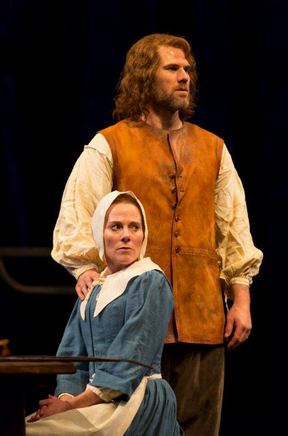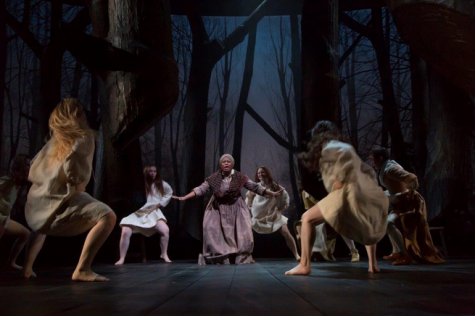Qureishy and Samarakoon win Guthrie review contest
May 21, 2015
UPDATE: The Rubicon editors Noor Qureishy and Amodhya Samarakoon have taken top honors in The Guthrie Review Writing Event held Apr. 29. Qureishy’s review took first place in the contest, and Samarakoon’s took third.
They saw The Crucible, which runs through May 24, and submitted their reviews to a statewide contest sponsored by the Minnesota High School Press Association along with reviews from the other attendees.
You can read their reviews below.

Erik Heger plays
John Proctor in The Crucible.
The Crucible explores the timeless question of morality
BY NOOR QUREISHY
The dark blues and blacks of twilight light up the thrust stage, casting an eerie light on the trees that loom over the audience, fog drifting around the feet of the actors as they chant, spin, and dance to an ominous tune only they know. “The Crucible” at the Guthrie, portrayed by a cast of over 20 actors, tells a story steeped in raw human emotion and vitality. Director Joe Dowling’s suspenseful, witty vision, combined with the cast’s beautifully honest portrayal of humorous, yet often dangerously flawed characters engages the audience for the entirety of this play. Despite the seriousness of the plot, “The Crucible” is nothing less than stunning.
Set in 1692, Arthur Miller’s play, “The Crucible” tells the story of the townsfolk that live in Salem during a time where fear of witchcraft leads to life-threatening accusations, as petty jealousies and arguments take precedence over innocence in the courtroom. John Proctor (Erik Heger) struggles with his own morality and sense of justice as his own wife, Elizabeth (Michelle O’Neill) is accused of being a witch by Abigail Williams (Chloe Armao), a young woman he had an affair with. As paranoia overwhelms the town, no one is free from suspicion, and hundreds of women are accused of engaging in witchcraft: as Reverend Hale says, “Nothing’s left to stop the whole green world from burning.”
Suspense builds from the very first act of “The Crucible,” as young women are found dancing in the middle of the woods, supposedly consorting with the devil. Although this play has its share of solemn moments, as many innocent women face the death penalty, the subtle, but clever humor scattered throughout the script lightens the atmosphere at just the right times, drawing laughter and allowing the audience to relate to the characters as three-dimensional, terribly honest beings. By creating the perfect balance between wit and terrifying tension, the cast of “The Crucible” lets the audience empathize with the character’s emotions in all their glory.
Dowling’s exceptional use of space, as a way to convey emotion, by having the actors pace, scamper, or stomp along the length of the stage when appropriate connects the audience with the story on a whole new level. The lighting, sometimes dark and frightening, at other times mellow and sweet, also corresponds with the intensity of each scene, allowing tension to build beautifully. Changing their volume and timbre, subtly but effectively is also a skill the cast excelled at; this was best employed by Michelle O’Neill, who portrays Elizabeth Proctor as a noble, sweet woman that every audience member is rooting for, and Erik Heger, who manages to make John Proctor seem, with his blunt commentary and brash manner, like a man fully redeemed by the end of the show.
Heger also illustrated John Proctor’s moral struggle brilliantly, as he tried to decide whether to lie and save himself, or remain with the righteous and accept the death penalty for supposedly dabbling in witchery. “The Crucible” explores questions of shady morality, pride, and true courage as the century-old debate of whether the right thing to do is really worth it, in the end, resurfaces, one of the many aspects of this play that makes it truly timeless. The cast of “The Crucible” at the Guthrie will captivate audiences with their wonderful chemistry and raw talent; revitalizing an exquisite classic that will engage any audience, both emotionally and intellectually.

The opening scene of The Crucible.
The Crucible: To lie or die
BY AMODHYA SAMARAKOON
The fog billows out from either side of the thrust stage while the piercing screams of young girls fill the air. The trees lift up from the stage while footsteps fade, signaling the end of the first scene. As the crew quickly preps the stage for the next scene, the audience hums in awe, immediately captivated by the varying tones and movements which reach every corner of the stage and fill every crevice of the theater.
The Crucible, directed by Joe Dowling, which premiered on April 29th at The Guthrie, is set in 1692 Salem, Massachusetts. Based directly off the play written in 1953 by Arthur Miller, this performance served to effectively illustrate John Proctor’s – a farmer played by Erik Heger – struggle with morality and truth in an extremely religious Puritan town during the Salem Witch Trials. After a group of young girls were witnessed dancing in a forest late at night, the girls as well as other townspeople began pointing fingers at one another, left and right, declaring that he or she was a witch and needed questioning, culminating into the Salem Witch Trials.
The first few minutes of the performance immediately evoke an ominous feeling, almost of dread. The haunting backdrop of a forest reiterates this dark undertone in each scene which follows, reminding the reader of the witchery that went down in the forest, even as the young girls deny it profusely. Then, suddenly, the tone of the play shifts, and every few lines a character slips in a humorous comment, drawing laughter from the crowd which contrasts with the ominous tone established in the first scene. Dowling’s use of subtle comedy feels out of place at first, but later on provides much needed relief from the tension of high energy scenes while also reminding the viewers to stop holding their breath.
Dowling made brilliant use of the stage’s massive amount of space, placing actors in specific spots in order to direct the audience’s focus towards the center of the stage while simultaneously fostering a more intimate connection between the actors and audience. Two actors with noteworthy abilities to act with movement, filling the given space, were Ashley Rose Montor and Chloe Armao who played Mary Warren and Abigale Williams respectively – two of the young girls found partaking in rather witchy activities.
Another skill to which Armao is clearly adept, along with Greta Oglesby who plays Tituba – a slave from Barbados who gets caught up in the witchery – is the ability to speak one’s lines rhythmically, allowing the tempo to convey emotion sans piercing screams and wailing. Of course there were plenty of shouts and yelps throughout the performance, but only when truly necessary. The way Armao and Oglesby spoke their lines felt almost poetic, and they did this without breaking the necessary tension, anger or supernatural vibe of the scenes, leaving one holding back the urge to poetry-slam-snap in the wake of one of their monologues.
In contrast, Heger’s tremendous stage presence and booming voice took hold of every member in the audience during the quick, little moments which called for unexpected raised voices and loud footsteps. Heger was able to effectively portray the internal struggle of his character – between remaining truthful and hanging, or signing back his life on a lie regarding the witchery he was accused of participating in. Is refusing to bow down and lie in order to save one’s life vain and prideful? Or courageous, honest and good? Questions such as these are not only relevant to the Salem Witch Trials, but can be applied to anyone’s current situation regardless of the time period, enabling this play to be retold and adapted countless times over the many years for which it has existed.
Dowling’s casting choices clearly show different performing skill sets between each actor, but they compliment each other very well on stage. The cast members respective talents in each of these areas combined to create a very rhythmic and nearly musical performance, with hushed voices and wild movements interwoven with bursts of high-pitched wails and deep-toned accusations. As long as there is good and evil, God and witchery, deception and honesty, people will inevitably face a struggle with their own skewed moral compasses in the pursuit of making the “right” decision. It will truly remain timeless and relevant.
This piece was originally published on May 2 and was updated May 21 to reflect the contest results and add the by lines of the writers.